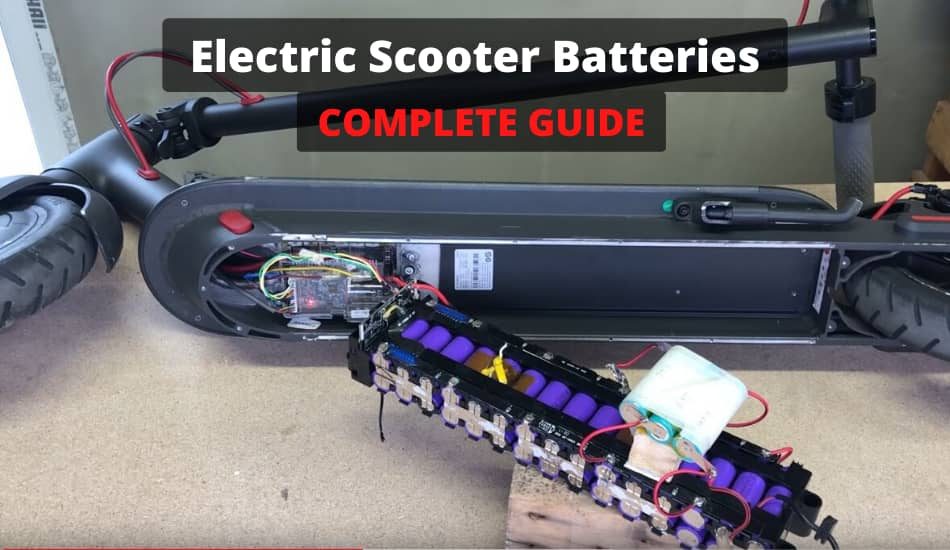
It is clear that without a battery, even the best electric scooter will not pass even a mile. Therefore, batteries are a key component and they directly affect the reliability and overall functionality of every electric scooter. There are several types of batteries with different operating principles, power, capacity and other key components that are important. The most modern and commonly used battery type in electric scooters is a lithium battery. If you ever wondered why some modern electric scooters are so expensive, then this may be due to the cost of the battery. In this article, we will go through all the battery specifications, pros and cons, ways of use, storage, and much more. So let’s begin.
Electric Scooter Battery Intro
Battery for electric scooters are drastically different from those found in phones or laptops in terms of energy and power, especially if you intend to move at high speeds over long distances. The batteries in your electric scooter are the main and only source of energy. They store energy that your electric scooter uses through the DC motor, controller, and lights.
The vast majority of today’s electric scooters have some sort of lithium-ion battery packs. The reason why lithium batteries are the most commonly used in electric scooters is that they give the most energy density per weight. All scooters have battery packs where they have a number of identical battery cells that are configured in a series or parallel.
A bigger battery packs have more power that is measured in watt hours, which allows your electric scooter to cover a greater distance. But with more power comes the extra weight and size of the scooter, which makes him less portable.
Main Battery Characteristics
• Battery Capacity (Ah)
The capacity of the battery is most often taken as the amount of electricity equal to 1 C, with a current strength of 1 A for 1 s (when translating time into hours, we get 1 Ah = 3600 C). However, they are accepted, not measured. If we use an example, where we have a battery with a 1 Wh, we get that the battery can supply 1 Watt of power for 1 hour. So if we have more energy capacity we have more Wh which gives us a longer range for our electric scooter. An average electric scooter have a battery capacity of around 250 Wh which is approximately 10 miles (16 km). Advanced electric scooters have a much larger capacity, around 2000 Wh and can cross a range of up to 70 miles (110 km).
• Energy Density (Wh/kg)
Energy density – the amount of energy per unit volume or unit mass of the battery. The energy density describes how much energy per volume can be drawn from a battery. It is given in Watt hours per kilogram (Wh/kg). The higher the energy density, the lighter a battery is with the same amount of energy that is stored. Lithium-ion batteries have a gravimetric energy density that is three times higher than that of lead-acid batteries. This means that a lithium- ion battery, which stores the same amount of energy as a lead-acid battery, weighs only a third of the lead-acid battery. That’s why most of electric scooters use lithium-ion batteries.
• Self-discharge
Self-discharge is the loss of battery power after a full charge in the absence of load. Self-discharge manifests itself differently in different types of batteries, but it is always maximum in the first hours after a charge, and after that, it slowly reduces the stored charge down. For Ni-Cd batteries, no more than 10% of self-discharge is considered acceptable for the first 24 hours after charging. In Li-ion, it is extremely small and manifests itself significantly only within a few months after charging. This is another reason why lithium-ion batteries are used in electric scooters. They discharge about 5% in the first 24 hours, and they lose 1 to 2% per month.
• Operating Temperature
You must keep your’s electric scooter batteries away from fire and water, excessive heating and cooling, and sudden changes in temperature. Do not use batteries at temperatures above + 50°C and below −25°C. When you are using your electric scooter in a cold winter, it is recommended to remove and store the battery it in a warm room after you finish your ride. Violation of the temperature can lead to a reduction in cycle life or loss of performance.
Types Of Electric Scooter Batteries

The battery types mainly differ according to the different materials from which the electrodes are made. Nowadays, mainly nickel metal hydride (NiMH) and lithium ion batteries are used. In the past, nickel-cadmium batteries were used, but they only had a very short lifespan. Here we will explain the advantages and disadvantages of every battery that is used in electric scooters today. So let’s begin:
Electric scooters are powered by four types of batteries:
- Nickel Metal Hydride Battery (NiMH)
- Lithium-ion Battery (Li-ion)
- Lithium Nickel Manganese Cobalt Oxide (NMC)
- Lithium Iron Phosphate (LFP)
1. Nickel Metal Hydride Battery (NiMH)
- Cycle durability: ~ 2000 cycles
- Specific energy: ~ 120 Wh/kg
- Specific power: ~ 250 W/kg
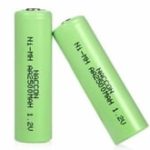
This type of battery has been on the market for many years. Their name explains their chemical composition. They are lighter than lead acid batteries. Thanks to this and the fact that they are more technologically advanced, nickel metal hydride batteries are quite expensive. NiMH batteries are typically designed specifically for the electric scooters, in which they power the entire system. It’s important to know that although batteries of this type are more expensive than lead-acid batteries, they are thirty percent lighter and last longer.
2. Lithium-ion Battery (Li-ion)
- Cycle durability: ~ 500 cycles
- Specific energy: ~ 265 Wh/kg
- Specific power: ~ 340 W/kg

The Li-ion batteries are the lightest on the market and last three times longer than conventional sealed lead-acid (SLA) batteries, which makes them very attractive to electric scooter manufacturers. They weigh a little less than nickel-metal hydride batteries, and half as much as lead-acid batteries. There are other factors that make lithium-ion battery technology so popular: they require less maintenance if not used. They do not suffer from the “memory effect” problem, as nickel-metal hydride batteries do, and they can last a long time without any maintenance. As a result of these significant advantages, lithium-ion batteries appear more and more often as a component of the power unit of a scooter. However, their price is often much higher than that nickel-metal hydride batteries.
3. Lithium Nickel Manganese Cobalt Oxide (NMC)
- Cycle durability: ~ 2000 cycles
- Specific energy: ~ 220 Wh/kg
- Specific power: ~ 300 W/kg

One of the most successful versions of the lithium-ion electrochemical system is the combination of nickel, manganese, and cobalt (NMC) in the cathode. By analogy with lithium manganese, these systems can be optimized for capacity or power. For example, an NMC battery in a cell size of 18650 for moderate load has a capacity of 2800 mAh and can provide a current strength of 4-5A; and the version in the same size, but optimized for power indicators, has a capacity of only 2000 mAh, but its maximum discharge current is 20 A. The secret of NMC technology is the combination of nickel and manganese. NMC batteries are used for powerful tools, electric scooters and other power units. The composition of the cathode, as a rule, combines nickel, manganese, and cobalt in equal parts. The distribution is also known as 1-1-1.
4. Lithium Iron Phosphate (LFP)
- Cycle durability: ~ 5000 cycles
- Specific energy: ~ 160 Wh/kg
- Specific power: ~ 200 W/kg
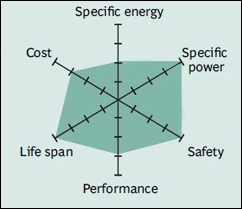
These batteries have the largest lifetime among lithium batteries – from 1500 to 7000 cycles or 10-25 years. At the same time, they have the lowest specific energy consumption among lithium batteries. They are able to discharge and charge very high currents. Lithium phosphate batteries are the safest among lithium batteries, which is extremely important when we talk about the use of electric scooters. They can be discharged in severe (up to -30°C) frost with a slight loss of capacity and they are the only lithium batteries that can be charged at low temperatures using a special technique. The combination of these properties makes the LiFePO battery an almost ideal candidate for electric scooters. Ready-made batteries often have a higher price and increased weight, however, a huge resource and stability of parameters allows them to operate for a long time.
Battery Packs
Battery for electric scooters. The main component of a battery is its cells. The battery packs are group of cells that are put together in one unit. The reason why battery packs are used is that the voltage of a single cell is not sufficient for practical use. Battery pack is a set of any number of preferably identical battery cells that are configured in a series or parallel to deliver the desired voltage, capacity or power density. The most used battery packs are lithium ions due to the high power density they provide. Every electronic device, including an electric scooter, today has a battery pack to meet market demands and provide more power.
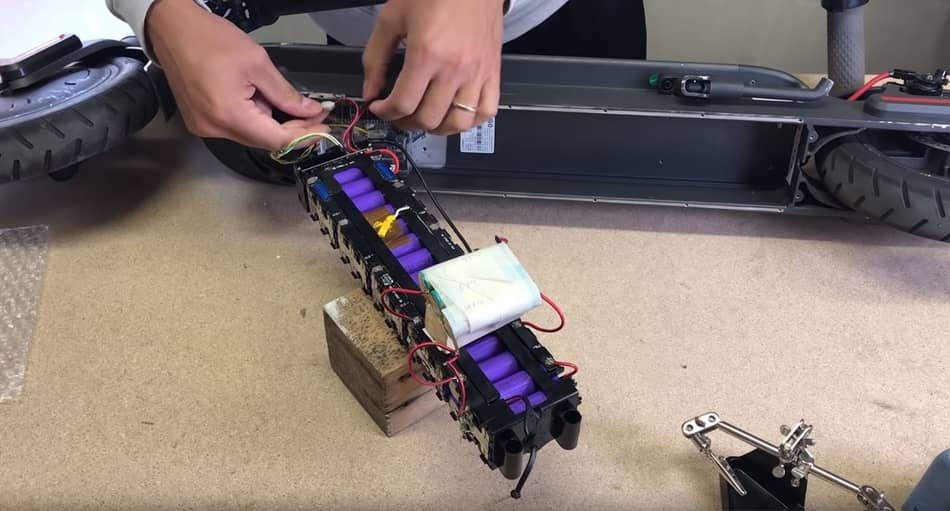
Lithium Ion batteries provide high power density and have the largest market share of battery packs in the world. So, electric scooters are made of many individual cells that make up one battery pack. Rechargeable battery packs often contain a temperature sensor which the battery charger uses to detect the end of charging. The battery pack is controlled and monitored by a circuit that is called a battery management system (BMS), which has control over the inputs and outputs of electricity from the battery.
Battery Management System (BMS)
Lithium batteries that are used in most electric scooters, are sensitive to overcharging, as well as to discharge below a certain voltage. In order to reduce the risk of damage to individual battery cells and battery failure in general, batteries are equipped with a special electronic balancing circuit – the battery management system (BMS). Battery Management System (BMS) is an electronic system that controls the charge/discharge process of the battery, is responsible for the safety of its operation and monitors the state of the battery.
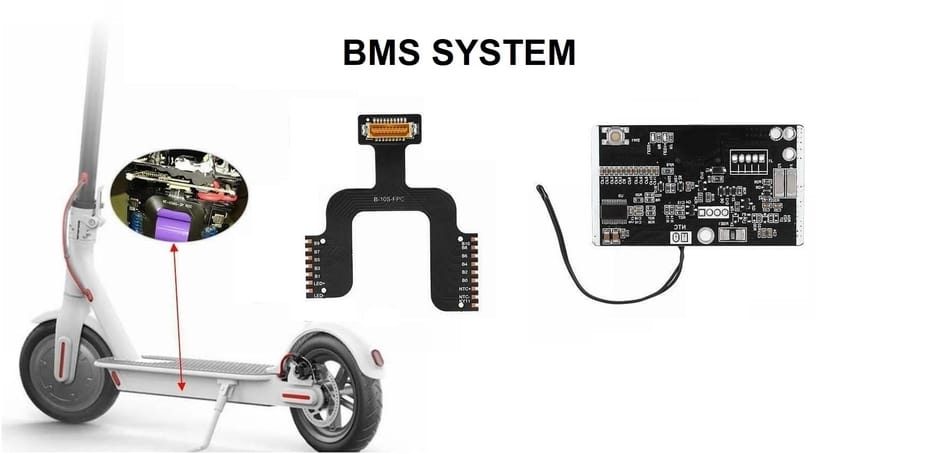
BMS performs cell charge balancing, protects the battery from short circuit, current overload, overcharge, over-discharge (high and excessively low voltage of each cell), overheating and overcooling. The functionality of BMS allows not only to improve the operating mode of rechargeable batteries but also to maximize their life time. The BMS can monitor the battery voltage, temperature, internal resistance and can measure the battery level with high accuracy to inform the user about the exact condition of the battery.
Battery Life Of Electric Scooters
When the battery reaches its end of life, its discharge capacity drops to the value established by the technical documentation, and the battery must be replaced. But with proper care, the battery can last 3 to 5 times longer. The answer to the question of how long a lithium-ion battery lasts depends on a number of factors. When we talk about Li-ion battery, they are able to handle approximately 300 to 500 charge cycles. When it comes to the average electric scooter, that means that the scooter can cross from 5,000 to 10,000 miles (16,000 km). BMS systems are designed to help to prolong the battery life.
Ways to Extend The Battery Life On An Electric Scooter:
- Avoid Very Deep Discharges: You must know that very deep discharges can permanently damage your Li-ion battery. To extend the life of lithium batteries, you must: Prevent them from being completely discharged – with repeated deep discharges with high currents. If the battery is completely discharged, you need to charge it at least 40%.
- Avoid Charging to 100% Capacity of Your Electric Scooter: You can do this by selecting a lower float voltage. Avoid overcharging and do not leave it connected to the charger for a long time after the charging process has been completed. If you reduce the float voltage, you will increase the cycle life.
- Battery Temperature Sensitivity: Don’t operate your electric scooter at the temperatures below -20°C or above +50° Batteries are very sensitive at temperatures below 0°C and can be damaged, as well as at high temperatures. Avoid overheating and hypothermia.
- Storage temperature: Keep them charged at 40-50% at temperatures from 0 to +15 °C. If the device is left to be stored in an almost discharged state, due to the probable self-discharge, its capacity may drop to a critical value, and in the future, it will not be possible to charge the battery at 100%. Long-term storage leads to a decrease in the capacity of the device.
Electric Scooter Battery Descriptions
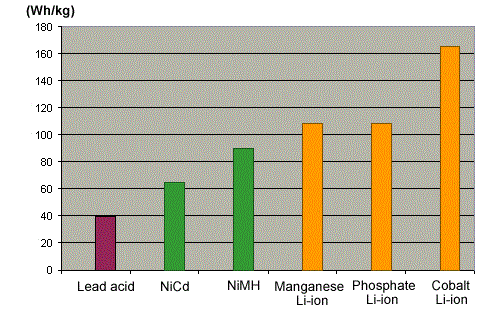
Batteries for electric scooters. Electric scooter brands always describe battery details to show how powerful they are. Numbers are usually followed by units such as Volt (v) and Amp-hours (Ah), but what are these numbers, and are they useful for determining how powerful a battery is? Let’s find out.
- Volt (V)
Voltage is a unit of measurement of electric potential between 2 points. For example, batteries have a positive (+) and negative (-) charge and a connector for both of these “poles”. The rated voltage is the potential difference between the positive and negative terminal of the battery without load and, therefore, without current flow. Typically, the higher the load on the battery, the more current will flow through the load circuit. The electric current measured in amperes is described in more detail below:
- Amp per Hour (Ah)
Ampere per hour is a unit of measurement for electric current. Electric current is the amount of electrical energy that flows through a wire at any given point. Thus, the amount of energy that flows through the connecting wire per second is called the rated current. For example, a battery with a capacity of 8 Ah (amperes per hour) will discharge in an hour with a load generating a current of 8 amperes. Usually this is the maximum number, since the amount of current available can only decrease when the battery is low.
Electric Scooter Battery Weight
The weight of the battery can greatly affect the operation of the scooter because even light batteries can increase the power required for its use. Due to the fact that electric scooters can be made of carbon fiber or light aluminum alloys, it often turns out that batteries are the heaviest element of a scooter. The weight of one battery can vary from 5 to 26 kg, so you must consider the weight when disassembling the electric scooter for storage and transportation. We have already mentioned that most electric scooters use li-ion batteries because they give the best ratio of strength and weight.
Charging Electric Scooter
All electric scooter batteries can be charged using the built-in or external charger. The advantage of external chargers is that they reduce the overall weight of the scooter and are less likely to fail. Since they are not subject to scooter vibrations, they will last longer, but not so with scooters with an internal charger.
It is important to remember that one of the factors that is determining the battery life of an electric scooter is proper charging in accordance with the instructions. Carefully read the manufacturer’s recommendations to understand how to properly charge the scooter.
Another thing to watch out for is overcharging the scooter battery. When you frequently recharge the battery, the chemical composition of the batteries changes, which reduces the battery life. Typically, you have the light indicator that lights up when the battery is fully charged. Some batteries may become recharged, and some are installed with overcharge protection.
Replacing Electric Scooter Batteries
If the battery on your electric scooter breaks down or loses a lot of capacity and cannot be fully charged, it needs to be replaced. Some people think that when the battery on a scooter breaks down they have to replace the whole scooter, instead, they just need to replace the battery on it. Today we have many battery manufacturers and their specifications may vary slightly. Therefore, pay attention when choosing a battery, because you must choose the one that is compatible with your scooter. If you do not know how to replace the battery on your electric scooter yourself, contact the nearest service center. Here is the full article on How To Replace The Battery On An Electric Scooter.
https://www.youtube.com/watch?v=gDjm1yxg0mo
Why Electric Scooter Batteries Are Not Eco-Friendly?
Electric scooters are one of those things that more and more people use every day. Due to the fact that they are more environmentally friendly than other modes of transport, we can all contribute to improving the environment. Their environmental friendliness stems from the fact that they are powered by a battery instead of gasoline or any other fossil fuel burned.
On the other hand, electric scooters are not ideal since the manufacture and disposal of batteries can cause serious environmental pollution if the batteries are not recycled properly. There are many rules and regulations on the production and disposal of hazardous materials, but when they are manufactured abroad, we lose some of this control.
In addition, the energy used by electric scooters must obviously come from somewhere, i.e. You must charge your scooter at home or in the office. It is easy to think that you are using clean energy, the electricity used to charge the scooter can be obtained from any source of energy, such as energy from a coal-fired power plant. However, there is nothing completely perfect and electric scooters are certainly much cheaper and more environmentally friendly than cars, even gas-powered cars.
Battery Tips For Your Electric Scooter
Batteries, if used properly, can extend their life. We recommend that you read the list below if you want to extend the life of your battery on an electric scooter.
- Make sure that you are using a charger that is compatible with the batteries of your scooter when charging.
- If you use an electric scooter daily, then you need to charge it daily.
- If you do not use the electric scooter daily, then you should charge it once every three months.
- Recharge the battery immediately after driving.
- Ensure that the battery is fully charged before removing the plug from the outlet.
- Putting the battery into a partially charged state may shorten its life.
- The new battery must be charged at 100% before first use.
- Always store the electric scooter and battery in a cool, dry place.
- Exposure to moisture can damage the battery.
- If the scooter or battery is wet, wipe it with a cloth.
Frequently Asked Questions About Batteries
Which Battery is Best For Electric Scooter?
The battery that is considered to be the best for electric scooter is the Lithium-ion battery (Li-ion). Li-ion batteries have three times longer battery life then Sealed Lead Acid (SLA) batteries. Another advantage that lithium-ion batteries have is they have the most energy density per weight. The weigh of li-ion is little less than NiMH.
How Much Does a Scooter Battery Weigh?
Batteries can sometimes be the heaviest part of electric scooter. The average weight of the battery on an electric scooter is approx from 3 to 10 kg. The weight of the battery usually depends on the type of battery and the model of the electric scooter.
How Long do Electric Scooter Batteries Last?
Most batteries on electric scooters last between 2 to 5 years which is equal to 3,000 to 5,000 miles (4,800 to 8,050 km). Battery life depends on storage, battery type, use conditions, temperature use, and charge current. Most batteries used in electric scooters have between 300 to 500 charging cycles before they start to lose their capacity.
What Type of Batteries do Electric Scooters Have?
Electric scooters mostly use batteries that are made of lithium ion (Li-ion) or Nickel Metal Hydride (NiMH). Lithium ion batteries give the most energy density per weight and that is the reason why they are most commonly used. The most common combinations of lithium that can also be found in electric scooters are Lithium Iron Phosphate and Lithium Nickel Manganese Cobalt Oxide.
How To Maximize Your Electric Scooter Battery Life?
If you treat your battery well, you can drastically increase its lifespan. So, to maximize the battery on your electric scooter you must adhere to the following rules: Before storing the battery, charge it to around 75%. Charging current must be under 2 A. Do not use the scooter in too cold temperatures (below 32 F) or too hot temperatures (above 114 F), as this will significantly affect battery life.
How to Store Electric Scooter Batteries?
The best way to properly store an electric scooter battery is to charge it to 75%. The room temperature where the battery will be stored should be above 32 F (0 C) and below 114 F (45 C). If the battery will be stored for a long time, make sure to charge it periodically so the battery does not be completely emptied.
